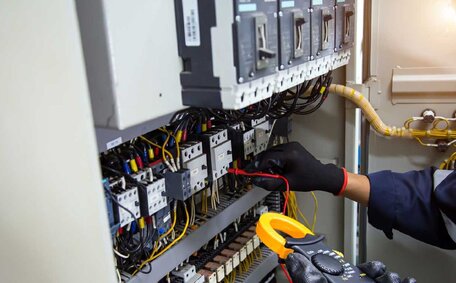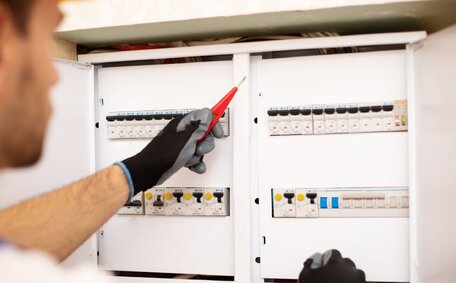
Pick the Best Switchboard for Your Business
A reliable switchboard is essential for a commercial property’s safety and efficiency. Discover key factors to ensure the right choice for your business needs.
Read MoreDid you know that electrical faults are a major fire risk in Australian homes? While the exact percentage varies by state, reports like those from New South Wales Fire and Rescue highlight electrical issues causing a substantial portion of house fires.
Ensuring your switchboard, the central hub of your electrical system, is in the right spot and functioning well is vital for reducing fire risks. This post dives into why relocating your switchboard properly matters for safety, meeting Australian Standards, and boosting efficiency. We’ll also guide you through the relocation steps so you’re ready.
Switchboard relocation means shifting the main point of electrical distribution in a building. It involves moving the switchboard, crucial for controlling your electrical system’s current and ensuring a steady power supply.

Switchboard relocations often happen due to building renovations, the need to optimise space, or to address safety concerns. Sometimes, moving the meter box is also necessary to fit new appliances and meet current electrical codes.
Relocating the electrical switchboard can also prevent electrical faults and enhance the overall functionality of the electrical system. Additionally, this process can involve a switchboard upgrade to meet increased electrical demands and include modern safety features such as residual current devices.
Proper planning and execution in relocating the switchboard are vital for safety and functionality. A licensed electrician or contractor should manage the meter box move, like installing new meter boxes and connecting the main power supply.
Upgrading appliances and performing switchboard upgrades are critical to accommodate modern appliances and reduce the monthly energy bill. Ensuring compliance with electrical codes and avoiding potential electrical faults require meticulous attention to detail during the relocation.
When done right, moving the switchboard and meter box results in a reliable and efficient electrical system, protecting both the building and its people.
Before we delve into the details of a switchboard relocation, it’s important to understand the feasibility of moving it in the first place. The answer is yes; a switchboard can be moved. But, the feasibility depends on several factors. Here’s what you need to consider:
The first step is an assessment by a qualified electrician. They’ll inspect your current switchboard location, the proposed new location (ideally cool, dry, and accessible), and the overall electrical system current. This helps identify potential challenges like:
Moving a switchboard can be a good idea if you’re undergoing a major renovation or simply want a more convenient location. Modern switchboards offer improved safety features like residual current devices (RCDs) that can protect against electrical shock.
However, consider these potential drawbacks:
It’s crucial to involve local, licensed electricians for switchboard relocation. They ensure everything is correctly installed to comply with Australian standards and safety regulations.
Upgrading your switchboard to a modern model with improved safety features and increased capacity for future needs might be recommended by your electrician after assessing your home’s electrical system.
Switchboard relocation is complex, needing careful planning to ensure everything works safely and properly. Let’s dive into the crucial steps for a successful switchboard move.

The first step involves thorough planning and assessment. Site assessment is crucial to determine the suitability of the new location for your switchboard. This includes analysing the load to ensure the new site can handle the home’s electrical demands and evaluating risks such as older switchboards with outdated wiring.
Local electricians provide a free quote and conduct a detailed inspection to identify any challenges, recommending switchboard upgrades if necessary to accommodate modern switchboards and devices required in Australian homes.
Adhering to local regulations and standards is essential. Property owners must obtain the necessary permits before any electrical work begins. Compliance with Australian standards ensures that the relocation meets all safety requirements. Professional services ensure that the new switchboard and meter box installations comply with these regulations, including the installation of a residual current device for enhanced safety.
Preparation involves several critical steps. Notifying relevant parties, such as utility companies, about the planned relocation is necessary to avoid disruptions. Scheduling the relocation at a convenient time minimises inconvenience to the household. Preparing the new site includes ensuring that the new meter box and associated meter boxes are ready for installation. Local electricians also prepare by gathering all required materials and equipment.
The execution phase is where the actual relocation takes place. First, the power is shut down to ensure safety. Next, the old switchboard is safely disconnected and removed. Professional electricians then move the switchboard to the new location, carefully reconnecting the wiring and installing the new switchboard. This phase might also involve installing a new electrical meter if the old one is outdated.
Once the switchboard is relocated, rigorous testing and verification are essential. Local electricians conduct thorough tests to ensure that the home’s switchboard functions correctly and safely. This includes checking the new meter and all connections ensuring that the electrical services meet the required standards. Testing guarantees that the switchboard can handle the electrical load and that all safety devices, such as the residual current device, are operational.
Switchboard relocation can hit a few snags, like unexpected wiring issues, tight spaces, or local compliance hurdles. Existing electrical setups might be outdated, and finding the right spot for the new meter box can be tricky.
To overcome these challenges, it is essential to engage experienced professionals in electrical work. They can identify and resolve any wiring complications efficiently. Space constraints can be managed by planning an optimal layout and possibly upgrading your switchboard to a more compact, modern version.
Ensuring compliance with local regulations requires thorough knowledge of standards, which professional electricians possess. Their expertise ensures that all electrical systems are correctly installed, making the switchboard relocation smooth and compliant.

Critical safety measures during switchboard relocation include proper insulation of all wiring, effective grounding, and strict adherence to electrical codes. Ensuring that the meter box and any old switchboards are safely handled and upgraded as necessary is vital for preventing electrical hazards.
Consulting qualified electricians is essential to mitigate risks and ensure the safety of the property and its occupants. Their expertise in electrical works, including how to upgrade your switchboard, guarantees that all safety standards are met and that the relocation is executed safely and efficiently.
Proper planning, professional involvement, and adherence to safety standards are crucial for a successful switchboard relocation. Thorough planning helps identify potential challenges, such as unexpected wiring issues and space constraints, ensuring a smooth process.
Working with expert electricians ensures safe disconnection of old switchboards and proper installation of new ones. Getting permits and sticking to local rules are key to safety. Measures like proper insulation, grounding, and following electrical codes help reduce risks and keep everyone’s well-being in check.
Bright Force Electrical is a trusted provider of switchboard services, including relocations, upgrades, and maintenance. Serving the northern suburbs, their friendly team of expert electricians offers professional services to ensure your electrical system is safe and efficient. Whether you need to upgrade your switchboard or relocate your meter box, Bright Force Electrical delivers reliable solutions tailored to your needs. Call their team today for a competitive quote and experience their exceptional service. With Bright Force Electrical, you can trust that your electrical works are in the best hands.
Did you enjoy reading our article “What Is Involved In A Switchboard Relocation”? We have many related articles you may also be interested in reading, like the below:
A reliable switchboard is essential for a commercial property’s safety and efficiency. Discover key factors to ensure the right choice for your business needs.
Read MoreFaulty wiring, outdated components, and hidden risks can compromise safety. A professional inspection identifies these issues before they become dangerous. Learn what experts look for, the steps involved, and how it helps prevent power failures or fire risks.
Read MoreSwitchboards are complex electrical distribution systems. This article provides a simplified guide on key factors in selecting the right switchboard, including safety, amperage capacity, voltage, excess current protection, and physical size. Learn how to choose a switchboard optimised for your facility’s electrical needs.
Read MoreWe will call back as soon as possible.



